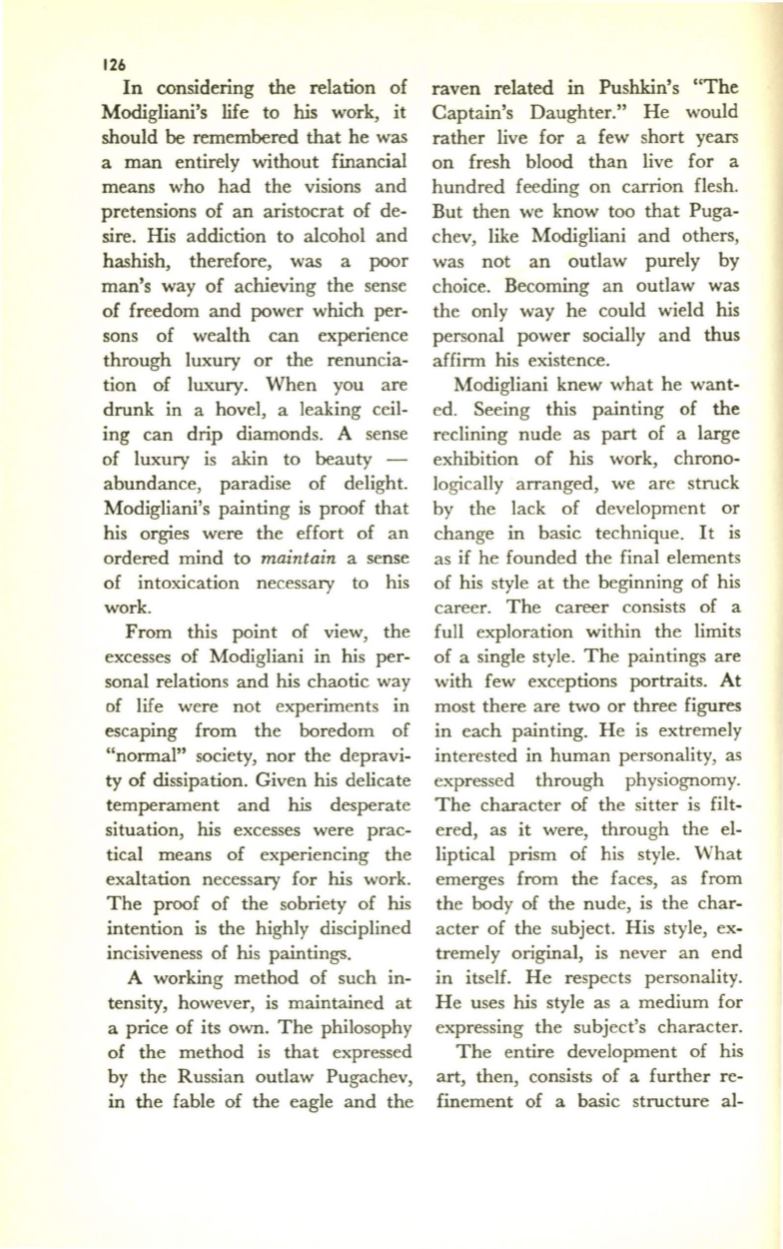
126
In considering the relation of
Modigliani's life to his work, it
should be remembered that he was
a man entirely without financial
means who had the visions and
pretensions of an aristocrat of de–
sire. His addiction to alcohol and
hashish, therefore, was a poor
man's way of achieving the sense
of freedom and power which per–
sons of wealth can experience
through luxury or the renuncia–
tion of luxury. When you are
drunk in a hovel, a leaking ceil–
ing can drip diamonds. A sense
of luxury is akin to beauty -
abundance, paradise of delight.
Modigliani's painting is proof that
his orgies were the effort of an
ordered mind to
maintain
a sense
of intoxication necessary to his
work.
From this point of view, the
excesses of Modigliani in his per–
sonal relations and his chaotic way
of life were not experiments in
escaping from the boredom of
"normal" society, nor the depravi–
ty of dissipation. Given his delicate
temperament and
his
desperate
situation, his excesses were prac–
tical means of experiencing the
exaltation necessary for his work.
The proof of the sobriety of his
intention is the highly disciplined
incisiveness of his paintings.
A working method of such in–
tensity, however, is maintained at
a price of its own. The philosophy
of the method is that expressed
by the Russian outlaw Pugachev,
in the fable of the eagle and the
raven related in Pushkin's "The
Captain's Daughter." He would
rather live for a few short years
on fresh blood than live for a
hundred feeding on carrion flesh.
But then we know too that Puga–
chev, like Modigliani and others,
was not an outlaw purely by
choice. Becoming an outlaw was
the only way he could wield his
personal power socially and thus
affirm his existence.
Modigliani knew what he want–
ed. Seeing this painting of the
reclining nude as part of a large
exhibition of his work, chrono–
logically arranged, we are struck
by the lack of development or
change in basic technique. It is
as if he founded the final elements
of his style at the beginning of his
career. The career consists of a
full exploration within the limits
of a single style. The paintings are
with few exceptions portraits. At
most there are two or three figures
in each painting. He is extremely
interested in human personality, as
expressed through physiognomy.
The character of the sitter is filt–
ered, as it were, through the el–
liptical prism of his style. What
emerges from the faces, as from
the body of the nude, is the char–
acter of the subject. His style, ex–
tremely original, is never an end
in itself. He respects personality.
He uses his style as a medium for
expressing the subject's character.
The entire development of his
art,
then, consists of a further re–
finement of a basic structure al-


